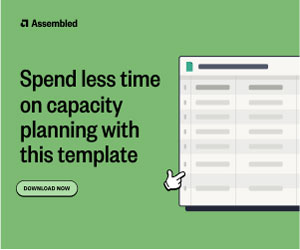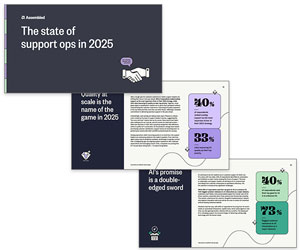Writing for Assembled, Brad Cleveland outlines twelve budgeting principles to keep your contact centre resourced.
Budgets: some people love ‘em, some people hate ‘em, everybody needs ‘em. Crunching numbers and pouring over line items isn’t for everyone, but an effective budget is vital to keeping the contact centre resourced. Without a clear understanding of required resources and what the returns on those investments should be, the contact centre will struggle to reach its full potential.
Here are 12 essential principles to help you get your contact centre the budget it needs.
1. View the Budget as More Than a Document
If line items and number crunching are the total summarization of how you approach a budget, then you’re missing the point.
Budgeting is a communication process—one that presents a larger opportunity to learn about the business and make a case that’s a win for everyone (employees, customers, and the organization at large).
It’s all too common for managers to spend hours putting the details together, only to have their priorities swept away or diluted in a matter of minutes in the CFO’s office.
On the flip side, it’s not impossible for powerful budgetary agreements to happen over coffee with nary a spreadsheet in sight. Ultimately, it’s the effectiveness of your case that matters most—not the detail of your analysis.
When you see the budget as an ongoing dialogue and not just a document, you spend more of your energy on opening channels of communication, educating decision-makers, and highlighting key priorities and tradeoffs. In short, you focus on ensuring that the effort leads to the right results.
2. Answer the Big Questions
Budgeting doesn’t have to be a defensive exercise, but you should always be prepared to go on the defensive if necessary. This requires that you anticipate pushback and prepare responses to the questions that will inevitably arise.
Why are we spending this money? Why does the contact centre exist? Why are we spending more (or less) than last year?
These questions form the backdrop of the budgetary process. Sometimes the answers are addressed in the communication that takes place during the process, and sometimes they’re summarized in budgetary documents.
Regardless, those who are involved in preparing and approving the budget need a shared understanding of the value the centre contributes to the organization.
3. Keep the Focus on Results
Handling 1.7 million calls, achieving 90% first-call resolution, or hitting service level targets are not the results decision-makers are looking for. These are only means to an end.
As your centre’s objectives and focus mature from handling transactions efficiently to delivering great customer experiences, you’ll have a greater impact on business results—including revenues, profitability, market share, and word of mouth. Illustrating this connection focuses budgetary discussion on the things that matter most.
4. Base the Budget on a Clear Strategy
You can’t start the budgeting process without alignment of the contact centre’s direction and priorities.
Your customer access strategy is the framework that defines how customers will interact with your organization.
It’s also the de facto blueprint for the budget, defining who your customers are; when and how they want to reach you; the means by which you will identify, route, handle and track those contacts; and how you will leverage the information that comes from those contacts.
Without this foundation, budgetary decisions are likely to head off in many unrelated directions and may be at odds with your organization’s broader objectives.
5. Ensure That Budgeting is an Extension of Resource Planning
In well-run contact centres, forecasting, staffing, scheduling, and cost analysis are ongoing responsibilities.
These activities should remove much of the work from the budget process because the budget should ultimately be based on established forecasting and planning steps.
There’s an important principle at work here. Objectives should drive the budget—not the other way around.
If your budget is based solely on precedent (last year’s numbers), arbitrary decisions, or anything other than the objectives identified in your customer access strategy and workload predictions, you’re at a disadvantage from the start. And if that’s the case, you’ve got a great opportunity to reshape assumptions.
6. Identify Key Tradeoffs
What happens if the forecast is high? Low? What happens if you provide better levels of service? Worse levels of service? How much would you save/spend if …?
Once the budget for the expected workload and recommended resources is established, it’s fairly straightforward to rerun scenarios for both different workload assumptions and alternative service levels.
These scenarios will contribute to good budgeting decisions and will improve the understanding others have of contact centre dynamics.
7. Look for Opportunities to maximize cross-functional resources
Often, an organization’s overall results can be improved by investing more in one specific area. Rather than focus on expenditures in a departmental vacuum, an effective budgetary strategy is one that maximizes cross-functional resources.
For example, marketing managers might be willing to provide the contact centre with budget money to capture and analyze information on consumer trends and expectations.
Legal departments are increasingly helping the centre make the case for investments that will improve tracking and consistency in handling customer contacts.
And product development budget money may be directed to the contact center for improved analysis on customer suggestions and input.
Of course, these possibilities are only available to the degree that cross-departmental relationships and collaboration exist.
8. Highlight Investment Opportunities
Like many organizations in general, most contact centres are constantly searching for ways to do more with less. But there’s also a place for making some high-leverage investments in sensible and practical areas, including:
- Planning and process improvements
- Selective technology investments
- Management-level education
- Cross-sell and upsell programs
- Focused agent and supervisor coaching initiatives
- Research and development
The key is being selective—focusing on those areas that are most likely to yield a high return on investment.
9. Present the Budget Formally
This principle may seem like a contradiction given the emphasis on collaboration and communication. But a formal presentation can go a long way toward getting the buy-in you need.
By gathering all decision-makers together at one time, you can avoid answering the same questions several times with individual stakeholders.
This will also allow all in attendance to hear questions and comments from others, saving time and raising the general level of understanding more quickly.
10. Keep the Presentation Short and Uncluttered
Visuals are always an effective way of getting your point across, so use graphs and illustrations to break up the wall of text where possible.
Provide backup material as necessary, such as actual system reports (but not as a part of the main presentation). Sprinkle the conversation with real examples—“Evan Gerard, a business owner in Nashville and a new customer of ours, was one of the 1,600,000 customers we helped last year.
He contacted us because he was concerned that …” Examples bring realities to life. And service tradeoffs become much more relevant when the loyalty and positive word-of-mouth from Evan and 1,599,999 other customers are at stake.
11. Anticipate and Prepare for the Usual Questions
They’ve come up before and they’ll come up many times in the future:
- What did we spend on the centre in total last year?
- Did it accomplish what we intended it to?
- What was our ROI on these investments?
- What’s the contact per customer ratio? Sales per customer?
- Is growth in some channels (chat, social media, self-service) changing the workload for agents? (Reducing? Increasing? Altering?)
- What’s our cost per contact? Is it going down or up?
- What are you doing to reduce unnecessary contacts?
- Can we use the resources we have now to handle the expected workload?
There are others, and you probably know what they are in your situation. Be ready. These questions are your opportunity to shine.
Some may be quite relevant, some less so—but having a complete grasp of the facts will provide you with credibility throughout the process.
12. Ensure the Budgeting Process Is Honest and Responsible
You should always be realistic and candid about the recent past and whether the contact centre has been meeting its objectives.
The budget must put that in context with customer satisfaction, agent performance, and the objectives and funding that are being proposed.
It must support the mission of the organization and dovetail with the roles and requirements of other areas. And it must be transparent about opportunities and challenges.
Yes, effective budgeting requires some number crunching and analysis. But above all, it requires a clear direction, good communication, and a solid understanding of the contact centre’s needs and strategic contributions.
This is a process that will bring your leadership, communication skills, cultural savvy, and professional expertise to bear. View and treat it as the substantial opportunity it is.
This blog post has been re-published by kind permission of Assembled – View the Original Article
For more information about Assembled - visit the Assembled Website
Call Centre Helper is not responsible for the content of these guest blog posts. The opinions expressed in this article are those of the author, and do not necessarily reflect those of Call Centre Helper.
Author: Assembled
Published On: 13th Mar 2023 - Last modified: 21st Nov 2023
Read more about - Guest Blogs, Assembled, Brad Cleveland






 Assembled is a Support Operations platform that helps companies maintain exceptional customer experiences, no matter what lies ahead. Leading brands use Assembled's workforce and vendor management capabilities to make optimal staffing decisions, gain visibility into performance and productivity, and unlock new ways to serve evolving customer needs.
Assembled is a Support Operations platform that helps companies maintain exceptional customer experiences, no matter what lies ahead. Leading brands use Assembled's workforce and vendor management capabilities to make optimal staffing decisions, gain visibility into performance and productivity, and unlock new ways to serve evolving customer needs. 












